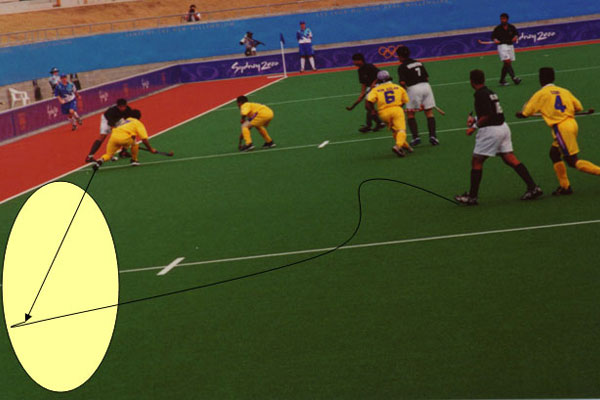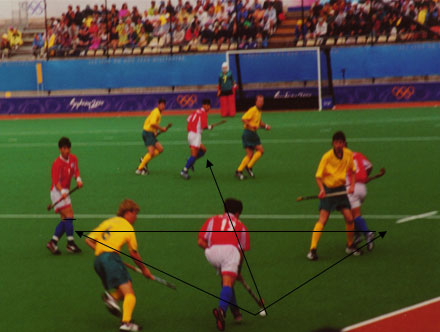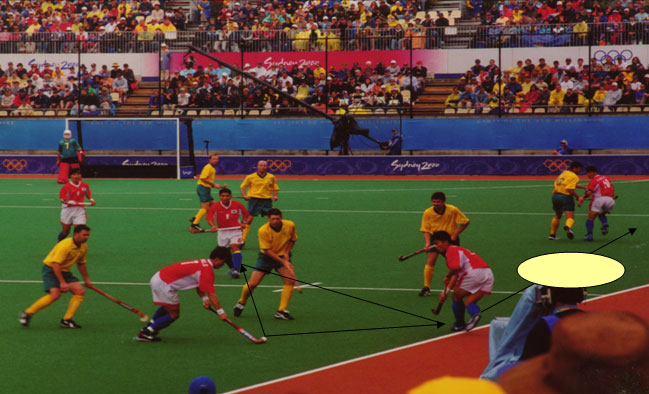Hockey
Playing
Styles

For more coaching information, visit www.coachshiv.com
| January | February | March |
|
April | May | June |
|  |
|||||
| July | August | September | October | November | December | |
![]()
This month's article is on different styles of hockey as adopted by the top 4 FIH-ranked teams in the world, with small variations as per their playing culture or environment.
|
The name of the game in hockey is passing and receiving. For passers, play first-time hockey and look for the simple pass. For pass receivers, if possible scan the field before receiving a pass. This saves valuable seconds in making the next pass or move.
Photo Illustration: The photograph below is from the 2000 Sydney Olympics, where the Pakistani centre-forward should do a quick scan of the field and position himself in the open space (highlighted in yellow). In parallel, the player with the ball or his closest teammate (right-half), can one-touch the ball into that open space. Close matches can be won or lost due to a difference of seconds and inches.

Pakistan vs. Malaysia in the Sydney 2000 Olympics
|
At an operational level, divide the team into mini-triangles in order to gain advantage over the opponents. These mini-triangles can be in various zone of the field - right side triangle, left side triangle, midfield triangle, and even in defence.
Within these triangles, play a give-and-go, one-touch, return pass hockey. This will give speed, width and depth to the attack and defence.
Photo Illustration: The Dutch use a guard system where the player attacking with the ball is supported at a 45-degree angle from the front and back. The photograph below is from the 2000 Sydney Olympics, where the Dutch forwards attacked the Canadian goalkeeper in a 3-on-1 triangle. The Dutch did score the goal in this particular situation.

Netherlands vs. Canada in the Sydney 2000 Olympics
Cross-sport Example: Basketball is one team sport where the triangle offence is often used. Phil Jackson, who coached the Chicago Bulls and later the Los Angeles Lakers to an NBA-record 9 titles, used to execute this simple but a powerful concept of a triangle offence.
|
Use a 60:40 ratio, with the ball being played 60% of the time on the right side, and 40% on the left side. Build the attack from the right side, and score goals from the left side, working passes through the centre-forward, left-in and left-out.
Photo Illustration: The photograph below is from the 2000 Sydney Olympics, where the South Korean team is attacking the Australian team using the right side triangle formation. South Korea finished with a silver medal in the Sydney Olympics, which remains to date their only Olympic medal of any hue in men's hockey.

Australia vs. South Korea in the Sydney 2000 Olympics
|
When the ball comes from the left-in to the centre-half, switch focus by passing to the right-in or the right-half. Once in a while, surprise the opponents by not switching foucs, and instead, attack with a return pass.
For example, during the 2008 Beijing Olympics semi-final match between Australia and Spain, Australia scored the first goal of the match less than 3 minutes into the game, employing this concept of left-to-right focus shift.
Australia intercepted the ball on their left side, passed to their centre-half, who made a hard, long pass to the right-out, who crossed the ball to the centre-forward, who did a first-time deflection of the ball into the goal. A beautiful piece of teamwork, utilising the width of the field.
|
This is an effective tactic to create space and bypass the opposing team's press. This gives flexibility to the team to change the focus of the play and the point of attack, depending upon a given situation.
While this has major advantages, it does come with its share of risks. On natural grass fields it is not easy to move the ball in the back. That could explain why this tactic is not common in some parts of the world, including India. This is still an effective strategy even on grass fields, albeit to be used with a bit more caution and deception.
|
This concept is not that frequently employed, even by the best teams in the world. However, there are certain match situations when interchanging of positions during the run of play catches the opponents napping.
Introduce this concept to the athletes when they are in their early to mid teens. It is hard to change the players' mindsets when they are in their late teens or early 20s.
|
The traditional styles of defence are Delaying, Channeling, Tackling and Covering. Employ the above styles using a combination of man-to-man and zone coverage.
In certain game situations, employ double-teaming or aggressive gang tackling strategies, especially when the opponents have been pushed to a corner of the field. In such cases, there is strength in having numbers behind the ball. In simple terms, defend as a team and attack as a team.
|
Set plays can be used in multiple game situations - Penalty Corners Offence and Defence, Out-of-D free hits, Sideline Free Hits, 16 Yards Offence and Defence. Do invest time in developing the set plays during the practice.
One reason for the consistent success of the top 4 FIH ranked teams is their high conversion rate in scoring and defending penalty corners. For validation, look no further than the German men's hockey team gold medal in the 2008 Beijing Olympics.
|
Shortlist a core set of 5 strategic team plays to create goal-scoring opportunities. Practice them a lot to develop their understanding, as they do generate goal-scoring opportunities in critical match situations.
|
Is offence the best defence? Or is defence the best offence? The coach and the players should adopt the appropriate style in a given match and situation, based on the strengths and weakness of the opponent.
|
Studies have indicated that an average player has ball possession for 3-5 minutes in an international match, depending upon one's role, position, skills etc. What the player does without the ball during the remaining 65 minutes dictates whether he receives the ball, and what he will be able to do on receipt of the ball.
Photo Illustration: Note that off-the-ball running is a team effort. This is exemplified by the photograph below from the 2000 Sydney Olympics match between South Korea and Australia. The Korean right half has overlapped with the forward line; the Korean right-out has taken the Aussie left-half with him to create space (highlighted in yellow) and thus open a lane for his teammate.

![]()